#FOR JSON AUTO
Explore tagged Tumblr posts
Text
checked errors expressed via sum-types is so good, especially if there's some species of inheritance for easy sum-type composition. I don't have to know what the hell any of the names mean but my coworkers can assign personal meaning to them, if I want to know what behavior triggers it I can just. yanno. ripgrep for throw @Error {whatever structured logging needs}
#would be nicer if there was a way to auto-reassociate sum types#the same way that safe coerce is basically 'fuk u u know what type i mean'#proposal for row types in haskell iirc is mostly a combination of not wanting to kill yourself when writing apis for 'idiomatic duck-typed'#json microservices where it can give you an int a string an undefined OR a null on error. and they all mean different things.#and also so you can write partial error handlers and you get good composition so as long as you handle all cases it typechecks
0 notes
Text
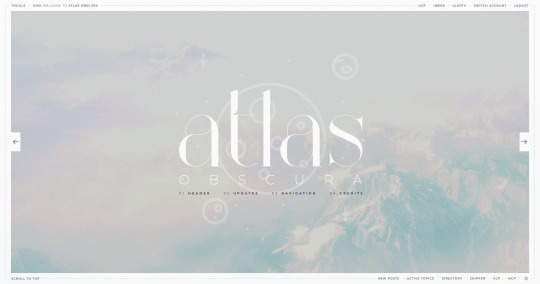
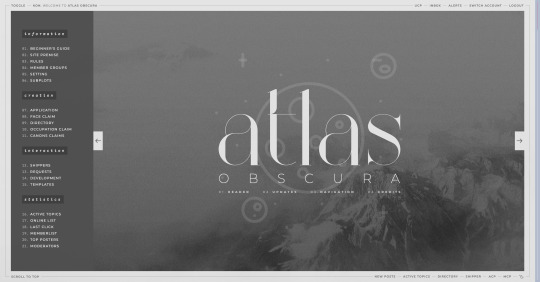
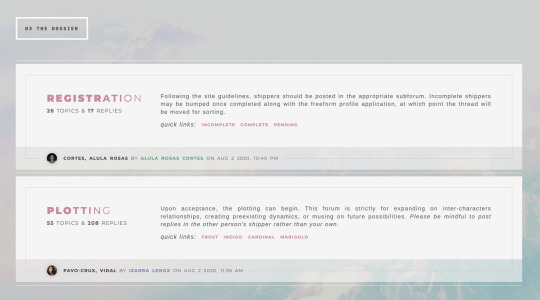
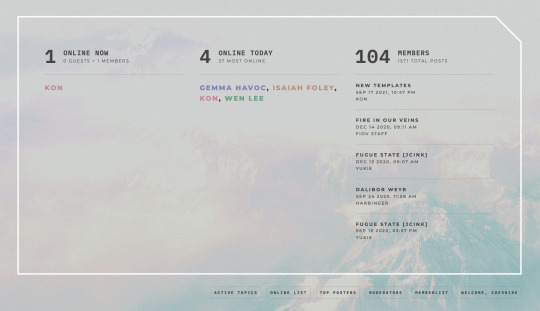

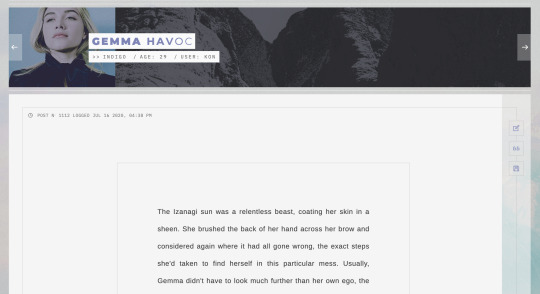
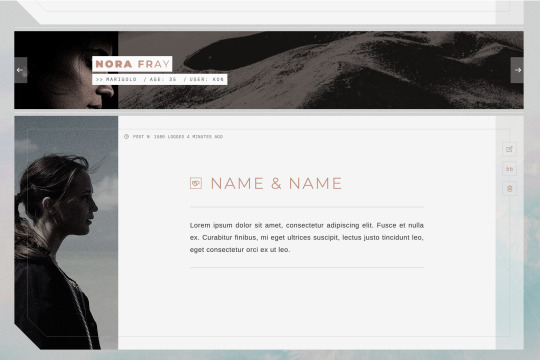
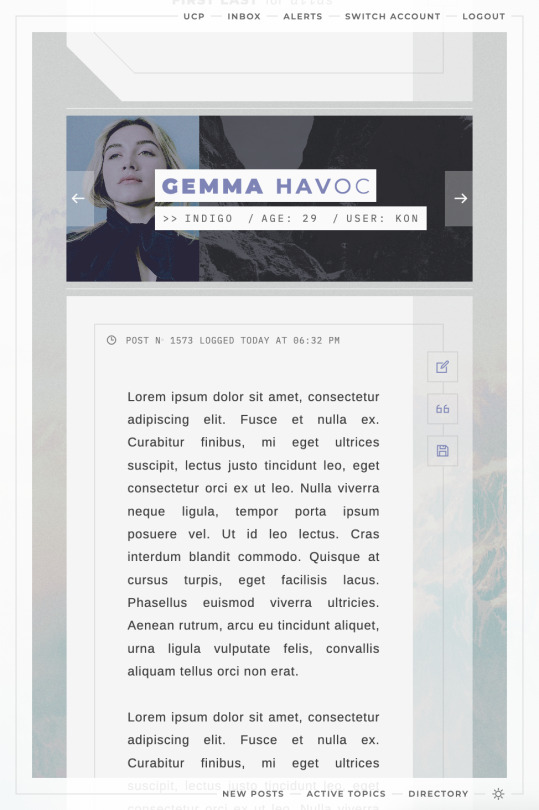
ATLAS OBSCURA (60$)
ATLAS OBSCURA is a fully flex skin optimized for Chrome but has been adjusted for compatibility across Firefox and Safari. A low contrast, dark background is recommended. A live preview can be requested at any time through my support discord. PURCHASE HERE: https://ko-fi[DOT]com/s/740013f3a4 WEBPAGES HERE: https://ko-fi[DOT]com/s/07654e42a0 TEMPLATES: https://ko-fi[DOT]com/s/020489ee5a
Includes:
light/dark toggle sidebar that auto transitions to a module for mobile custom forums, topics, memberlist, posts (optional larger post avatar with sticky) tabbed, popup application profile member group colors set up across the skin css variables set up for images, fonts, and colors for ease of editing guest to member links on login for easy navigation various indicators for messages/alerts customized tooltips tabbed header basic post template with all basic styles (bold, italics, h1 through h7, blockquote, hr, lists, etc)
Files:
full xml file html templates xml file easy to import field set json file general installation guide pdf skin specific instructions with member group prefix/suffix codes and user fields
Policies:
credit must remain intact and unchanged you may not claim my codes as your own at any point, nor may they be used as a base for other projects I offer unlimited support for bugs present at purchase
Please review the rest of my my policies prior to making any purchases: koncodes[DOT]tumblr.com/policies For questions or a live preview, you can contact me through ko-fi or my support discord: discord[DOT]gg/MXD5nDgDzq
153 notes
·
View notes
Text
made a little house of leaves text replacement script for Firefox with the FoxReplace extension ! instructions under the cut
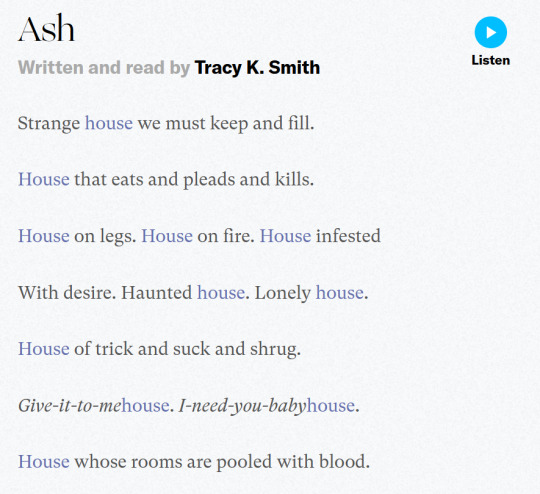
basically replaces house with
<span style ="color:#6570ae">house</span>
and minotaur with
<span style ="color:red"><s>minotaur</s></span>
firefox installation method:
get the FoxReplace extension: https://addons.mozilla.org/en-US/firefox/addon/foxreplace/
Script: save the following as a .json file, and import it into FoxReplace:
{ "version": "2.6", "groups": [ { "name": "House of leaves", "urls": [], "substitutions": [ { "input": "house", "inputType": "text", "outputType": "text", "output": "<span style =\"color:#6570ae\">house</span>", "caseSensitive": true }, { "input": "minotaur", "inputType": "text", "outputType": "text", "output": "<span style =\"color:red\"><s>minotaur</s></span>", "caseSensitive": true }, { "input": "House", "inputType": "text", "outputType": "text", "output": "<span style =\"color:#6570ae\">House</span>", "caseSensitive": true }, { "input": "Minotaur", "inputType": "text", "outputType": "text", "output": "<span style =\"color:red\"><s>Minotaur</s></span>", "caseSensitive": true } ], "html": "output", "enabled": true, "mode": "auto&manual" } ] }
notes:
I haven't finished House of Leaves yet so it currently only substitutes house and Minotaur.
Recommended to turn on Automatic substitution On page load
Not recommended to Apply automatic substitutions every few seconds, it moves your cursor in an opened text editor. sadly cant see the house in blue while im typing this post
-> edit: it only affects the tumblr post editor??
Not recommended to change the HTML to input&output (currently output only) because it would fuck up URLs and tags
4 notes
·
View notes
Text
you would not believe the amount of joy it brings me to have pretty errors. I'm insane I'm losing my mind I spent at least a dozen hours on this. but LOOK!!!!
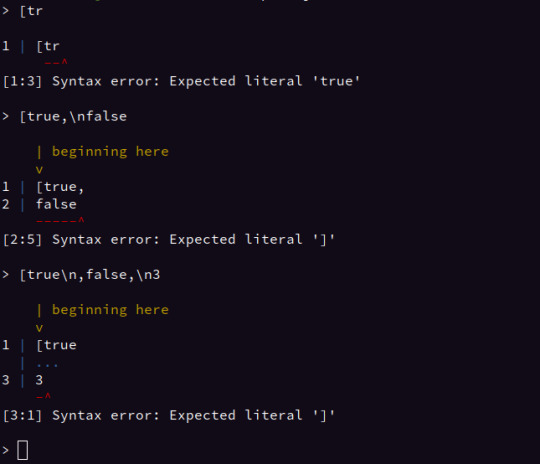
these are all auto generated!! all I did was *describe* the syntax of json with a formal grammar and this is what I get from that. I could now make ANY custom syntax and get these beautiful errors 🤤
28 notes
·
View notes
Text
Devlog #1
Ok, I've been working super hard on my game this week, and I have something to show off. Generally, I did not want to start doing Devlogs until I had what I considered a working prototype, and that's what this is. I think I'm at the point where a lot of basic things work, and I will be able to focus on building it out, which will make for more interesting regular updates.
So, what we're seeing in this clip is:
SPLASH SCREEN - just a test of animation and the flow of booting up the game, it will not be in there for long, I just threw random assets in.
SAVING & LOADING - The title screen is plain, the "Settings" option doesn't do anything yet, but the "New Game" and "Load Game" do! They currently go off of one filepath and save games are stored as JSON so I can edit them easily for testing, and they don't yet prompt "are you sure?", they just do it, and the functions work. I can save my game and all the party and player stats and values load in properly. [Not shown: there is a save button in the Pause menu, but that menu is very basic]
BATTLE UI - All is placeholder, and ugly, but I focused down on getting it to work. That means, while I was throwing buttons in there for testing early on, I spent major time reworking menus to work with controller instead. I may do KB&M support later, once the UIs are actually fully designed, but doing them in parallel while I'm changing things would not be nice. We can attack, you don't have to click "Confirm" anymore, just a controller button, we have spells/skill and items which can target either enemies or allies, and both single-target an multitarget skills exist and flash up corresponding selector arrows, after which you can confirm your target. Party members have an HP/MP display and the character whose turn it is will be highlighted on their turn
MESSAGE OVERLAY - As you can see, I've worked out the system to have messages give the player feedback in-battle which can also be used for dialogue out-of-battle. It works off of a queue containing both messages that auto-play and messages that you have to confirm before moving on, so I can mix-and-match as appropriate. I wanted to have this in place so I can soon implement NPCs and shops, and the battles make sense to both me and the player as I add more features to it.
When we load into this test dungeon, we see the old sprite for a demon, I redrew them, as you can see in the first random encounter. None of this is final though, these were also pretty quick I just wanted to discard the really lazy MS Paint-looking sprites If I'm going to be showing the game off more, I want it to be in a better light. I'm not even sure Demons and Bats will be common enemy types in the game, it's just for testing. Nothing that you're seeing is final, or even really fits the vibe in my, mind yet, but it's approaching something that looks like it has the potential to be a game.
After all all of this I haven't added any new enemy types, items, or skills yet, the assets aren't anywhere near what they will be like, no levels have been created yet, but I think what I have is a lot of the "structure" of a basic RPG. I ate my vegetables, the boring parts are functional, and it opens up a lot of doors for what I can develop next.
NEXT GOALS -
NPCs in the overworld (+Shops, need to have a way to acquire items, currently the inventory is hardcoded into a New Game)
Implement a method to recruit and dismiss new Party Members, they are also currently hardcoded for testing purposes
There are still lingering menu navigation bugs, but nothing that can't be fixed relatively quickly
Move the starting area to a safe-zone that can be built out as the main hub and create multiple dungeon rooms with different testing conditions
More visual feedback. Having enemies flash on taking damage and displaying damage numbers would be a good start, more complex animations can come later, including spell animations.
#slugdragoondevlog#slugdragoongame#gamedev#solodev#indiedev#rpg#drpg#game development#indiegamedev#indie games
21 notes
·
View notes
Text
Interloper Devlog #1 - April 2025
I am BACK!
My move was successful and my computer remained unharmed so i was able to get back to work on the game!
This month I spent working on various things but mostly systems stuff.
Save and load
================
I want to start with the saving and loading first since its the simplest.
Both Saving and Loading are separated into their own scripts that can be called whenever I need (such as save points)

Here is the code for Saving! I'll explain what each part does since its so short.
Set the "currentSaveFile" variable to open a specific file when called. In this case "Save.sav"
Set the "currentSaveJson" variable to a different variable "global.currentSave" that has been converted into JSON text.
Open the "Save.sav" file by referencing "currentSaveFile" then save the JSON text to the file by referencing "currentSaveJson"
Close the file.
Then do that again for saving options.
Now loading is basically the same, just read the JSON text then convert it back to a variable.
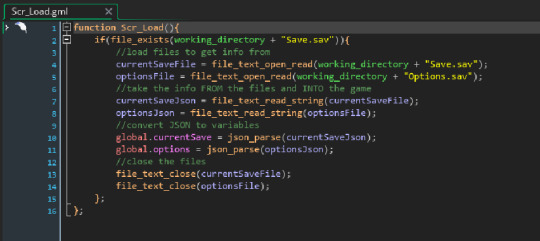
I'm not going to bother with a step by step here given the similar nature, something of note however is Line 2. Line 2 checks to make sure the file exists before attempting to load it, otherwise the game would crash if the file didn't exist.
Menu stuff
=============
Now its time to get into the goooood stuff, MENUS!
I looooved working on these so I'm quite excited to explain what I've done. Now most of what I've done is more systems stuff.
The menus are fairly fragmented across a few different objects and scripts so I'll have to be a bit more vague about the code.

So this is a menu, this is all the code needed to create one. If you wanted to create a menu for really anything this is what you'd type. This array contains 4 more arrays, with the following format.
[X,Y,Color,Text or Sprite],
Now there is more going on under the hood here, this alone wouldn't do anything. I have a fairly simple script that will auto draw each button by repeating multiple times per frame, the script will extract the length of the array and use the length as the repeat number. Each time it finishes drawing a button it'll go to the next button till its done all of them.

This code creates the background for the menu in a similar fashion. The format is slightly different but nearly the same.
[X1,Y1,X2,Y2,Color],
This will create a rectangle with the dimensions and color you want! The 'menuCMenu' rectangles create a black box with white outline!.
Now it should be noted that the position of the boxes in the array is VERY important. For the buttons the game uses the positions to decide which button to select next while navigating the menu, the background boxes use the order to decide which box is covered by another.
Putting both of these code snippets in actions gives us THIS!
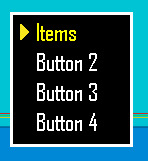
You may have noticed (or maybe not) that the "Items" text is yellow in this screenshot while the code states that it should be white. During the rendering process of the buttons i do a check, if a certain button is selected then make the text color yellow instead of whatever it's supposed to be.
Dialogue
===========
While not a total rework i did end up changing how dialogue works.

Dialogue was always formatted in a similar way to the menus however I did end up changing it slightly. Before each line was just floating around in what was destined to become a huge variable. Now that soon to be huge variable contains smaller variables that contain the dialogue trees!. So let me explain this code snippet.
[Face,Emotion,Text,Next Dialogue Line],
Lets start with the Face. The face is as simple as it sounds, type in the sprite you want to appear in the dialogue box, i.e "Face_August"
Now sometimes you don't want a face to appear so in those cases you would input "Face_Steve". This face does exist and has a corresponding sprite, the only reason its used here to display no face is because it's kinda funny. The code that draws the dialogue will see the "Face_Steve" input and will draw a different box with no face.


The Emotion refers to the sprites index. So if Emotion was 1 then it would change "Face_August" to display frame 1 of the index.
Text is self explanatory, only thing of note is that you can type "\n" to start a new line.
Next Dialogue Line refers to the specific position in the array. Arrays start counting at 0 i.e 0, 1, 2. So referencing Line 1 would cause the second line to start. Now you'd need to stop the dialogue eventually so in that case you'd type in -1 since you can't go negative in array positions.
Misc Stuff
=============
I have a few more things to mention, very minor however.
I have an object whose only job is to create other objects such as "Obj_Controls"
The controls object basically checks for inputs and will update global variables every frame based on the input data.
I have an object that creates a camera, that's about it.
and finally i have an object for Dev testing which contains some code for drawing debug info and what not.
Final Notes
============
I don't have too many things to say here other than Thank You for taking time out of your day to read! Have a nice day :)
3 notes
·
View notes
Text
Game Dev Log (6/8/2024)
Decided to keep a dev log of this game i'm making (aside from github). Might be interesting to some people
This is a long one. Maybe 2 weeks (cumulative) of progress here. Maybe around 10-15 hours of work? (A lot of it is learning Godot, I'm a unity refugee)
Pictures below the read more

Here's what the main screen looks like. Guy on the top left can move around to talk to the NPC.

Talking to him eventually brings up a choice. His dialogue is loaded in from JSON, we'll see if that changes.
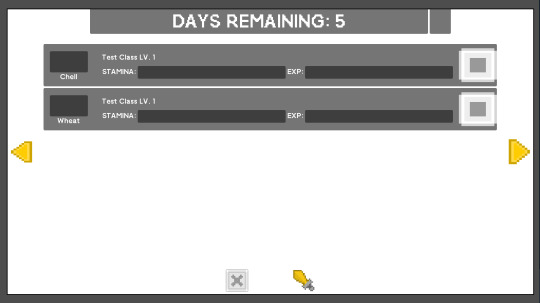
I have some temporary goats here. The arrow buttons don't work at the moment, I'm trying to get some gameplay in. Anyways, you can use the square buttons to cycle through jobs that these goats can do. Eventually it'll show the stat increases that job will give in the gray bars.
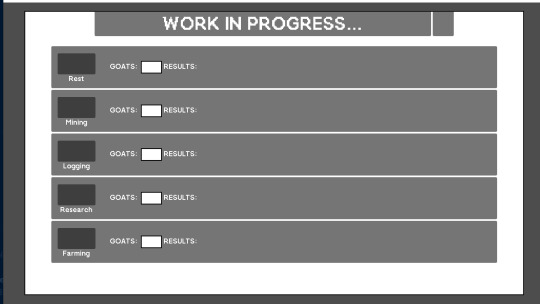
And here's what I've done today. Got some temporary job classes here that'll auto generate. Eventually that "results" section will populate with materials based on the goats' assigned jobs and their stats in that section...
Once I get this screen working then I'll have something resembling a game. You can give the goats jobs, those goats can increase their stats, and the next day moves forward. Obviously images and animations still need to be done, and there's a LOT of temporary code and TODOs just to get this section working.
Before I make more features I'm definitely going to go back and finish those TODOs. Not to mention, while dialogue is fairly scalable at the moment, I need to consider making JSON for the available goat characters and the jobs. I don't want this to bite me in the butt later, but I also don't want to get too caught up in efficiency before function...
Either way, it's a 2D game so it should run well enough, even if it's inefficient lol
#godot#indie dev#game dev#all these assets are ones i had on hand and are very temporary lol#you'll notice there are no goats here despite being a game about goats#dev log
5 notes
·
View notes
Text


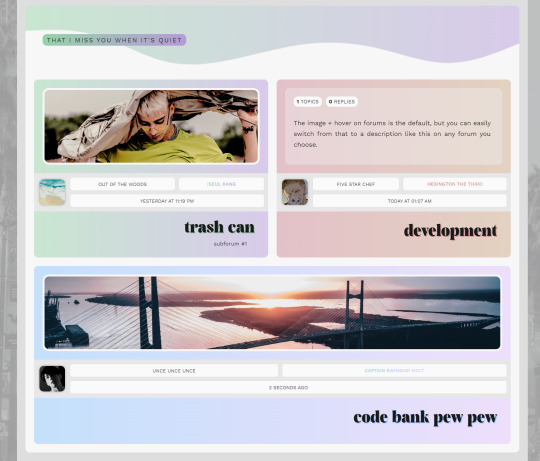




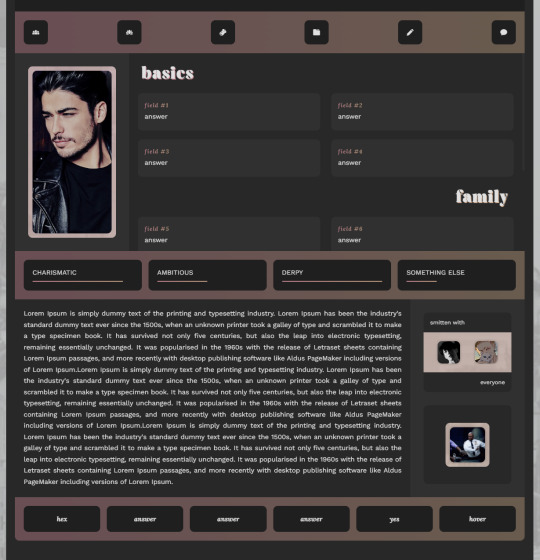
SUPERNOVA is a $60 (CAD) fully responsive, mobile-friendly Jcink skin. It's COSMIC but brighter. I’ve made it as user-friendly as possible with easy-to-edit variables and cues within the HTML which are also in the installation guide. No templates are included currently but a set will be coming. "Template Set #1 - DAYLIGHT" set is fully functional with this skin. Preview and purchase at: https://ko-fi[dot]com/s/ef1ae01047 Please read my terms of service before purchasing: hexxincodes.tumblr.com/post/721896465243537408/terms-conditions
DETAILS
- All colours, fonts, and images set as variables for easy editing - Dark/light toggle - Full HTML templates - Isotope member list - Guidebook with 18 tabs set - Skin changes colors according to member group (10 set up) - Half and full forums - Forums easy to switch between image + description and just description - Forums change accents w/ last poster - Full installation guide - Comes with post auto-saver UPON PURCHASE - Full xml file - HTML templates xml file - Profile fields json - Installation guide pdf - Guidebook txt file CREDITS Isotope memberlist script is by Essi, the dark/light toggle script was created by Yuno, #CODE script is by Nicole/Thunderstruck, icons are from Cappucicons, post autosaver by Black.
32 notes
·
View notes
Text
This Week in Rust 533
Hello and welcome to another issue of This Week in Rust! Rust is a programming language empowering everyone to build reliable and efficient software. This is a weekly summary of its progress and community. Want something mentioned? Tag us at @ThisWeekInRust on Twitter or @ThisWeekinRust on mastodon.social, or send us a pull request. Want to get involved? We love contributions.
This Week in Rust is openly developed on GitHub and archives can be viewed at this-week-in-rust.org. If you find any errors in this week's issue, please submit a PR.
Updates from Rust Community
Official
crates.io: API status code changes
Foundation
Google Contributes $1M to Rust Foundation to Support C++/Rust "Interop Initiative"
Project/Tooling Updates
Announcing the Tauri v2 Beta Release
Polars — Why we have rewritten the string data type
rust-analyzer changelog #219
Ratatui 0.26.0 - a Rust library for cooking up terminal user interfaces
Observations/Thoughts
Will it block?
Embedded Rust in Production ..?
Let futures be futures
Compiling Rust is testing
Rust web frameworks have subpar error reporting
[video] Proving Performance - FOSDEM 2024 - Rust Dev Room
[video] Stefan Baumgartner - Trials, Traits, and Tribulations
[video] Rainer Stropek - Memory Management in Rust
[video] Shachar Langbeheim - Async & FFI - not exactly a love story
[video] Massimiliano Mantione - Object Oriented Programming, and Rust
[audio] Unlocking Rust's power through mentorship and knowledge spreading, with Tim McNamara
[audio] Asciinema with Marcin Kulik
Non-Affine Types, ManuallyDrop and Invariant Lifetimes in Rust - Part One
Nine Rules for Accessing Cloud Files from Your Rust Code: Practical lessons from upgrading Bed-Reader, a bioinformatics library
Rust Walkthroughs
AsyncWrite and a Tale of Four Implementations
Garbage Collection Without Unsafe Code
Fragment specifiers in Rust Macros
Writing a REST API in Rust
[video] Traits and operators
Write a simple netcat client and server in Rust
Miscellaneous
RustFest 2024 Announcement
Preprocessing trillions of tokens with Rust (case study)
All EuroRust 2023 talks ordered by the view count
Crate of the Week
This week's crate is embedded-cli-rs, a library that makes it easy to create CLIs on embedded devices.
Thanks to Sviatoslav Kokurin for the self-suggestion!
Please submit your suggestions and votes for next week!
Call for Participation; projects and speakers
CFP - Projects
Always wanted to contribute to open-source projects but did not know where to start? Every week we highlight some tasks from the Rust community for you to pick and get started!
Some of these tasks may also have mentors available, visit the task page for more information.
Fluvio - Build a new python wrapping for the fluvio client crate
Fluvio - MQTT Connector: Prefix auto generated Client ID to prevent connection drops
Ockam - Implement events in SqlxDatabase
Ockam - Output for both ockam project ticket and ockam project enroll is improved, with support for --output json
Ockam - Output for ockam project ticket is improved and information is not opaque
Hyperswitch - [FEATURE]: Setup code coverage for local tests & CI
Hyperswitch - [FEATURE]: Have get_required_value to use ValidationError in OptionExt
If you are a Rust project owner and are looking for contributors, please submit tasks here.
CFP - Speakers
Are you a new or experienced speaker looking for a place to share something cool? This section highlights events that are being planned and are accepting submissions to join their event as a speaker.
RustNL 2024 CFP closes 2024-02-19 | Delft, The Netherlands | Event date: 2024-05-07 & 2024-05-08
NDC Techtown CFP closes 2024-04-14 | Kongsberg, Norway | Event date: 2024-09-09 to 2024-09-12
If you are an event organizer hoping to expand the reach of your event, please submit a link to the submission website through a PR to TWiR.
Updates from the Rust Project
309 pull requests were merged in the last week
add avx512fp16 to x86 target features
riscv only supports split_debuginfo=off for now
target: default to the medium code model on LoongArch targets
#![feature(inline_const_pat)] is no longer incomplete
actually abort in -Zpanic-abort-tests
add missing potential_query_instability for keys and values in hashmap
avoid ICE when is_val_statically_known is not of a supported type
be more careful about interpreting a label/lifetime as a mistyped char literal
check RUST_BOOTSTRAP_CONFIG in profile_user_dist test
correctly check never_type feature gating
coverage: improve handling of function/closure spans
coverage: use normal edition: headers in coverage tests
deduplicate more sized errors on call exprs
pattern_analysis: Gracefully abort on type incompatibility
pattern_analysis: cleanup manual impls
pattern_analysis: cleanup the contexts
fix BufReader unsoundness by adding a check in default_read_buf
fix ICE on field access on a tainted type after const-eval failure
hir: refactor getters for owner nodes
hir: remove the generic type parameter from MaybeOwned
improve the diagnostics for unused generic parameters
introduce support for async bound modifier on Fn* traits
make matching on NaN a hard error, and remove the rest of illegal_floating_point_literal_pattern
make the coroutine def id of an async closure the child of the closure def id
miscellaneous diagnostics cleanups
move UI issue tests to subdirectories
move predicate, region, and const stuff into their own modules in middle
never patterns: It is correct to lower ! to _
normalize region obligation in lexical region resolution with next-gen solver
only suggest removal of as_* and to_ conversion methods on E0308
provide more context on derived obligation error primary label
suggest changing type to const parameters if we encounter a type in the trait bound position
suppress unhelpful diagnostics for unresolved top level attributes
miri: normalize struct tail in ABI compat check
miri: moving out sched_getaffinity interception from linux'shim, FreeBSD su…
miri: switch over to rustc's tracing crate instead of using our own log crate
revert unsound libcore changes
fix some Arc allocator leaks
use <T, U> for array/slice equality impls
improve io::Read::read_buf_exact error case
reject infinitely-sized reads from io::Repeat
thread_local::register_dtor fix proposal for FreeBSD
add LocalWaker and ContextBuilder types to core, and LocalWake trait to alloc
codegen_gcc: improve iterator for files suppression
cargo: Don't panic on empty spans
cargo: Improve map/sequence error message
cargo: apply -Zpanic-abort-tests to doctests too
cargo: don't print rustdoc command lines on failure by default
cargo: stabilize lockfile v4
cargo: fix markdown line break in cargo-add
cargo: use spec id instead of name to match package
rustdoc: fix footnote handling
rustdoc: correctly handle attribute merge if this is a glob reexport
rustdoc: prevent JS injection from localStorage
rustdoc: trait.impl, type.impl: sort impls to make it not depend on serialization order
clippy: redundant_locals: take by-value closure captures into account
clippy: new lint: manual_c_str_literals
clippy: add lint_groups_priority lint
clippy: add new lint: ref_as_ptr
clippy: add configuration for wildcard_imports to ignore certain imports
clippy: avoid deleting labeled blocks
clippy: fixed FP in unused_io_amount for Ok(lit), unrachable! and unwrap de…
rust-analyzer: "Normalize import" assist and utilities for normalizing use trees
rust-analyzer: enable excluding refs search results in test
rust-analyzer: support for GOTO def from inside files included with include! macro
rust-analyzer: emit parser error for missing argument list
rust-analyzer: swap Subtree::token_trees from Vec to boxed slice
Rust Compiler Performance Triage
Rust's CI was down most of the week, leading to a much smaller collection of commits than usual. Results are mostly neutral for the week.
Triage done by @simulacrum. Revision range: 5c9c3c78..0984bec
0 Regressions, 2 Improvements, 1 Mixed; 1 of them in rollups 17 artifact comparisons made in total
Full report here
Approved RFCs
Changes to Rust follow the Rust RFC (request for comments) process. These are the RFCs that were approved for implementation this week:
No RFCs were approved this week.
Final Comment Period
Every week, the team announces the 'final comment period' for RFCs and key PRs which are reaching a decision. Express your opinions now.
RFCs
No RFCs entered Final Comment Period this week.
Tracking Issues & PRs
[disposition: merge] Consider principal trait ref's auto-trait super-traits in dyn upcasting
[disposition: merge] remove sub_relations from the InferCtxt
[disposition: merge] Optimize away poison guards when std is built with panic=abort
[disposition: merge] Check normalized call signature for WF in mir typeck
Language Reference
No Language Reference RFCs entered Final Comment Period this week.
Unsafe Code Guidelines
No Unsafe Code Guideline RFCs entered Final Comment Period this week.
New and Updated RFCs
Nested function scoped type parameters
Call for Testing
An important step for RFC implementation is for people to experiment with the implementation and give feedback, especially before stabilization. The following RFCs would benefit from user testing before moving forward:
No RFCs issued a call for testing this week.
If you are a feature implementer and would like your RFC to appear on the above list, add the new call-for-testing label to your RFC along with a comment providing testing instructions and/or guidance on which aspect(s) of the feature need testing.
Upcoming Events
Rusty Events between 2024-02-07 - 2024-03-06 🦀
Virtual
2024-02-07 | Virtual (Indianapolis, IN, US) | Indy Rust
Indy.rs - Ezra Singh - How Rust Saved My Eyes
2024-02-08 | Virtual (Charlottesville, NC, US) | Charlottesville Rust Meetup
Crafting Interpreters in Rust Collaboratively
2024-02-08 | Virtual (Nürnberg, DE) | Rust Nüremberg
Rust Nürnberg online
2024-02-10 | Virtual (Krakow, PL) | Stacja IT Kraków
Rust – budowanie narzędzi działających w linii komend
2024-02-10 | Virtual (Wrocław, PL) | Stacja IT Wrocław
Rust – budowanie narzędzi działających w linii komend
2024-02-13 | Virtual (Dallas, TX, US) | Dallas Rust
Second Tuesday
2024-02-15 | Virtual (Berlin, DE) | OpenTechSchool Berlin + Rust Berlin
Rust Hack n Learn | Mirror: Rust Hack n Learn
2024-02-15 | Virtual + In person (Praha, CZ) | Rust Czech Republic
Introduction and Rust in production
2024-02-19 | Virtual (Melbourne, VIC, AU) | Rust Melbourne
February 2024 Rust Melbourne Meetup
2024-02-20 | Virtual | Rust for Lunch
Lunch
2024-02-21 | Virtual (Cardiff, UK) | Rust and C++ Cardiff
Rust for Rustaceans Book Club: Chapter 2 - Types
2024-02-21 | Virtual (Vancouver, BC, CA) | Vancouver Rust
Rust Study/Hack/Hang-out
2024-02-22 | Virtual (Charlottesville, NC, US) | Charlottesville Rust Meetup
Crafting Interpreters in Rust Collaboratively
Asia
2024-02-10 | Hyderabad, IN | Rust Language Hyderabad
Rust Language Develope BootCamp
Europe
2024-02-07 | Cologne, DE | Rust Cologne
Embedded Abstractions | Event page
2024-02-07 | London, UK | Rust London User Group
Rust for the Web — Mainmatter x Shuttle Takeover
2024-02-08 | Bern, CH | Rust Bern
Rust Bern Meetup #1 2024 🦀
2024-02-08 | Oslo, NO | Rust Oslo
Rust-based banter
2024-02-13 | Trondheim, NO | Rust Trondheim
Building Games with Rust: Dive into the Bevy Framework
2024-02-15 | Praha, CZ - Virtual + In-person | Rust Czech Republic
Introduction and Rust in production
2024-02-21 | Lyon, FR | Rust Lyon
Rust Lyon Meetup #8
2024-02-22 | Aarhus, DK | Rust Aarhus
Rust and Talk at Partisia
North America
2024-02-07 | Brookline, MA, US | Boston Rust Meetup
Coolidge Corner Brookline Rust Lunch, Feb 7
2024-02-08 | Lehi, UT, US | Utah Rust
BEAST: Recreating a classic DOS terminal game in Rust
2024-02-12 | Minneapolis, MN, US | Minneapolis Rust Meetup
Minneapolis Rust: Open Source Contrib Hackathon & Happy Hour
2024-02-13 | New York, NY, US | Rust NYC
Rust NYC Monthly Mixer
2024-02-13 | Seattle, WA, US | Cap Hill Rust Coding/Hacking/Learning
Rusty Coding/Hacking/Learning Night
2024-02-15 | Boston, MA, US | Boston Rust Meetup
Back Bay Rust Lunch, Feb 15
2024-02-15 | Seattle, WA, US | Seattle Rust User Group
Seattle Rust User Group Meetup
2024-02-20 | San Francisco, CA, US | San Francisco Rust Study Group
Rust Hacking in Person
2024-02-22 | Mountain View, CA, US | Mountain View Rust Meetup
Rust Meetup at Hacker Dojo
2024-02-28 | Austin, TX, US | Rust ATX
Rust Lunch - Fareground
Oceania
2024-02-19 | Melbourne, VIC, AU + Virtual | Rust Melbourne
February 2024 Rust Melbourne Meetup
2024-02-27 | Canberra, ACT, AU | Canberra Rust User Group
February Meetup
2024-02-27 | Sydney, NSW, AU | Rust Sydney
🦀 spire ⚡ & Quick
If you are running a Rust event please add it to the calendar to get it mentioned here. Please remember to add a link to the event too. Email the Rust Community Team for access.
Jobs
Please see the latest Who's Hiring thread on r/rust
Quote of the Week
My take on this is that you cannot use async Rust correctly and fluently without understanding Arc, Mutex, the mutability of variables/references, and how async and await syntax compiles in the end. Rust forces you to understand how and why things are the way they are. It gives you minimal abstraction to do things that could’ve been tedious to do yourself.
I got a chance to work on two projects that drastically forced me to understand how async/await works. The first one is to transform a library that is completely sync and only requires a sync trait to talk to the outside service. This all sounds fine, right? Well, this becomes a problem when we try to port it into browsers. The browser is single-threaded and cannot block the JavaScript runtime at all! It is arguably the most weird environment for Rust users. It is simply impossible to rewrite the whole library, as it has already been shipped to production on other platforms.
What we did instead was rewrite the network part using async syntax, but using our own generator. The idea is simple: the generator produces a future when called, and the produced future can be awaited. But! The produced future contains an arc pointer to the generator. That means we can feed the generator the value we are waiting for, then the caller who holds the reference to the generator can feed the result back to the function and resume it. For the browser, we use the native browser API to derive the network communications; for other platforms, we just use regular blocking network calls. The external interface remains unchanged for other platforms.
Honestly, I don’t think any other language out there could possibly do this. Maybe C or C++, but which will never have the same development speed and developer experience.
I believe people have already mentioned it, but the current asynchronous model of Rust is the most reasonable choice. It does create pain for developers, but on the other hand, there is no better asynchronous model for Embedded or WebAssembly.
– /u/Top_Outlandishness78 on /r/rust
Thanks to Brian Kung for the suggestion!
Please submit quotes and vote for next week!
This Week in Rust is edited by: nellshamrell, llogiq, cdmistman, ericseppanen, extrawurst, andrewpollack, U007D, kolharsam, joelmarcey, mariannegoldin, bennyvasquez.
Email list hosting is sponsored by The Rust Foundation
Discuss on r/rust
2 notes
·
View notes
Text
Audio Editing Process
Hey all, just thought I'd make regarding the process I used to make the new audio for the Northstar Client mod I'm working on.
Really quick here are some helpful sites
First, the software. You'll need to download
Audacity
Northstar Client (NC. Also I'm using the VTOL version)
Steam
Titanfall 2
Legion+ (from same site as NC)
Titanfall.vpk (also from NC)
Visual Studio Code(for making changes to .json files if necessary)
And that should be about it for now. Feel free to use whatever audio program you want. I just audacity cuz it's free and easy to use.
NOTE: if you want to skip a lot of headache and cut out the use of Legion+ and Tfall.vpk you can download a mod from Thunderstore.io and then just replace all the audio files with your new ones
This makes pulling a copy of an original unedited file for changes (if necessary) super easy, as well as making the exported file easy to find
Step 1.
First you'll want to get organized. Create a folder for all your mod assets, existing or otherwise and try to limit any folders within to a depth of one to make them easier to navigate/find stuff.
Example being:
<path>/mod_folder
|-->voicelines_raw (place all your audio in here)
|-->voicelines_edited (export to this folder)
|-->misc (add however many folders you need)
Above is an example of a folder with a depth of 1
First select your audio from the file you created earlier and import it into Audacity
Step 2.
Put any and all audio into their proper folder and open Audacity.
For my project I need to have some voicelines made seperately for when inside the titan, and when outside.
These instances are prefaced with a file tag "auto" and looks like this
diag_gs_titanNorthstar_prime_autoEngageGrunt
Inside "audio" in the mod folder you will see a list of folders followed by .json files. WE ONLY WANT TO CHANGE THE FOLDERS.
Open an audio folder and delete the audio file within, or keep it as a sound reference if you're using Legion+ or Titanfall vpk.
Step. 3
Edit your audio
Click this button and open your audio settings to make sure they're correct. REMINDER 48000hz and on Channel 2 (stereo)
As you can see I forgot to change this one to channel two but as another important note you'll want to change the Project Sample rate with the dropdown and it's pictured and not just the default sample rate.
In this example I needed to make the voiceline sound like it was over a radio and I accomplished that by using the filter and curve EQ. This ended up being a scrapped version of the voiceline so be sure to play around and test things to make sure they sound good to you!
Afterwords your audio may look like this. If you're new, this is bad and it sounds like garbage when it's exported but luckily it's an easy fix!
Navigate to the effects panel and use Clip Fix. play around with this until the audio doesn't sound like crap.
Much better! Audio is still peaking in some sections but now it doesn't like it's being passed through a $10usd mic inside a turbojet engine.
Next you'll need to make sure you remove any metadata as it will cause an ear piercing static noise in-game if left in. Find it in the Edit tab.
Make sure there's nothing in the Value field and you're good to go!
Export your project as a WAV and select the dedicated output folder
Keep your naming convention simple and consistent! If you're making multiple voicelines for a single instance then be sure give them an end tag_01 as demonstrated in the picture above.
Step 4.
You're almost done! Now you can take audio from the export folder and copy+paste it right into the proper folder within the mod. You can delete the original audio from the mod folder at any time.
Also you won't need to make any changes to the .json files either unless you're creating a mod from scratch
NOTE: As of right now i have not resolved the issue of audio only playing out of one ear. I will make an update post about this once I have found a solution. Further research leads me to believe that the mod I am using is missing some file but recreating those is really easy once you know where to look. Hint: it's in the extracted vpk files
#modding#mods#titanfall#titanfall 2#titanfallmoddy#audio editing#northstar client#northstar#vpk#legion+
2 notes
·
View notes
Text
okay I now have a plan on what I want to add next to the prototype of that game I keep sporadically talking about.
Gonna be adding entities for items, storing their stats and such based on designs from an sql database.
Bonus points if I can also add something to auto-generate classes for the designs based on their jsons (surely that exists right?)
2 notes
·
View notes
Text
Best API of Horse Racing for Betting Platforms: Live Odds, Data Feeds & Profits Unlocked

Discover the most accurate and profitable API of horse racing with live odds, betting data feeds, and fast integration. Ideal for UK/USA markets and fantasy apps.
Introduction: Why Accurate Horse Racing APIs Matter in 2025
In the competitive world of sports betting and fantasy gaming, milliseconds and margins matter. When it comes to horse racing, success hinges on real-time, trustworthy data and sharp odds. Whether you run a betting exchange, fantasy app, or affiliate site, using the right horse racing API can mean the difference between profit and failure.
The API of horse racing offered by fantasygameprovider.com is engineered to meet this demand—providing live horse racing odds, race entries, results, and predictive analytics that align perfectly with the betting industry’s needs.
What Is a Horse Racing API?
A horse racing API is a service that delivers structured, real-time horse racing data to apps, websites, and betting platforms. This includes:
Live race updates
Racecard entries & scratchings
Odds feed (fixed & fluctuating)
Final results with payout info
Jockey, trainer, and form data
These are typically delivered in JSON or XML formats, allowing seamless integration with sportsbooks, exchanges, or fantasy game engines.
📊 Who Needs Horse Racing APIs?
Audience
Use Case
Betting Sites
Deliver live odds, matchups, and payouts.
Fantasy Sports Platforms
Use live feeds to auto-update scores & leaderboards.
Betting Tipsters/Affiliates
Showcase predictive models based on fresh data.
Mobile Apps
Enable live race streaming with betting APIs.
Trading Bots
Automate wagers with low-latency horse racing data.
Why Choose FantasyGameProvider’s Horse Racing API?

Unlike basic feeds, our API is tailored for commercial use. Here's why it stands out:
Feature
FantasyGameProvider
Other APIs
Live Odds Feed
✅ Updated in <2s
⚠️ 5–15s delay
Global Racing
✅ UK, USA, AUS, HK
⚠️ Limited coverage
Data Format
✅ JSON + XML
⚠️ JSON only
Accuracy
✅ Enterprise-Grade (99.9%)
⚠️ Variable
Predictive Insights
✅ AI-Driven Models
❌ Not Included
Betting Integration
✅ Easy with Betfair, SBTech
⚠️ Manual setup required
Our horse racing odds API not only mirrors UK and USA live betting markets, but also lets you build automated bet triggers and smart notifications for sharp edge betting.
💸 How Betting Businesses Profit with Horse Racing APIs
If you're running a betting website or fantasy sports app, here's how the API of horse racing can boost your ROI:
Real-time updates = More active users
Faster odds delivery = Better arbitrage potential
Accurate results = Fewer payout disputes
Live data = Higher session times (ideal for monetizing with ads)
Custom alerts = VIP features for paid subscribers
Fantasygameprovider.com also allows white-label API integration to match your brand.
How to Choose the Right Horse Racing API – Checklist ✅
Make sure your API includes the following:
✅ Live odds feed with fast refresh rate (sub-2 seconds ideal)
✅ Coverage of all major race tracks (UK, USA, AUS)
✅ Reliable JSON & XML format
✅ Built-in historical data & form guide
✅ Scalable architecture for high traffic
✅ Supports Betfair, Oddschecker, and other exchanges
✅ Licensed data provider
Our API meets all these criteria and goes further by offering automated betting signals and predictive race modeling—key for next-gen apps.
Betfair API vs FantasyGameProvider: Which Is Better?
Feature
Betfair API
FantasyGameProvider
Odds Feed
Excellent (exchange-based)
Excellent (market + exchange)
Historical Data
Partial
Full form + performance stats
Developer Simplicity
Moderate
Plug-and-play REST endpoints
Support
Community-based
24/7 Support
Customization
Limited
High (webhooks, triggers, filters)
Pricing
Tiered
Affordable & negotiable plans
Conclusion: If you want full access to live odds, race data, and fast integration without the steep learning curve, fantasygameprovider.com offers better developer flexibility and betting UX.
Data Feeds You Get with Our Horse Racing API

Racecards & scratchings feed
Real-time results feed
Odds feed (fixed, fluctuating, exchange-compatible)
Form & stats feed
Track conditions feed
Horse/jockey/trainer history feed
Automated alerts for betting patterns
Formats available: JSON horse racing data & horse racing XML feed.
FAQs: Betting-Focused Horse Racing API Questions
Q1. Which is the most accurate horse racing API in 2025?
FantasyGameProvider offers 99.9% accuracy with sub-2-second update latency, ideal for professional and retail bettors alike.
Q2. Can I use this API for UK and USA horse racing?
Yes, our UK racing odds data and USA racing API are both available with full schedule and live result support.
Q3. Is your horse racing API suitable for Betfair automation?
Absolutely. Many of our clients use it to build Betfair trading bots using our odds feed and predictive race data.
Q4. Do you offer free trials or sandbox testing?
Yes. Developers can access a sandbox environment to test endpoints before committing.
Q5. What’s the difference between JSON and XML feeds?
JSON is faster and easier to integrate, while XML is preferred for legacy systems. We offer both to suit all tech stacks.
🚀 Start Winning with the Best API of Horse Racing
If you’re serious about building a winning betting platform, profitable tipster site, or a fantasy sports engine, you need the most accurate and commercial-ready API in the industry.
At fantasygameprovider.com, we give you everything:
✅ Live odds ✅ Fast results ✅ Race cards ✅ Predictive models ✅ Betfair compatibility ✅ Global reach (UK, USA, AUS, more)
👉 Ready to dominate the betting space with live horse racing data? Visit fantasygameprovider.com and request your API demo today.
#live cricket odds api#sports betting#betting#bettingapi#fantasygameprovider#Live odds#API of Horse Racing#UK racing odds data#Betfair#Real-time results feed#Betfair API
0 notes
Text
Generative AI in IT Workspace: A Game Changer for Tech Teams
The rise of generative AI has transformed how we perceive automation, creativity, and productivity across industries. For the IT workspace, it's not just a trend—it's a revolution. Tech teams, from software developers and IT operations to cybersecurity experts and DevOps engineers, are beginning to witness a paradigm shift in how they approach tasks, solve problems, and innovate.

Understanding Generative AI in the Context of IT
Generative AI refers to algorithms that can create new content or data based on training input. Unlike traditional automation, which executes predefined commands, generative AI learns patterns and generates solutions, code, or content that didn’t exist before.
In IT, this includes:
Generating code snippets or full applications.
Auto-remediating system errors.
Crafting documentation and reports.
Simulating cybersecurity threats.
Enhancing user support with intelligent bots.
Tools like OpenAI’s Codex, GitHub Copilot, and ChatGPT, as well as domain-specific platforms like Tabnine or Replit, are already helping tech teams unlock new efficiencies.
Key Benefits of Generative AI in Tech Workspaces
1. Boost in Developer Productivity
One of the most visible impacts of generative AI is in software development. With tools like Copilot or Amazon CodeWhisperer, developers can auto-complete code, generate boilerplate, and receive real-time suggestions based on best practices. This reduces time spent on routine coding tasks and allows developers to focus on logic, architecture, and innovation.
Example: A developer writing a function in Python to parse JSON data can get an accurate code suggestion within seconds, reducing hours of research or debugging.
2. Smarter IT Operations (AIOps)
Generative AI aids in predictive analytics, root cause analysis, and incident response. It can generate solutions to infrastructure issues, automate troubleshooting steps, and even learn from past incidents to improve future responses.
Use Case: An AI system might detect abnormal server behavior, automatically propose a remediation script, and document the incident—saving hours of manual intervention.
3. Enhanced Cybersecurity
Cybersecurity analysts can leverage generative AI to simulate threats, detect anomalies, and create dynamic security playbooks. AI-generated scripts can test system vulnerabilities or respond to attacks in real time.
Impact: Faster identification and response to zero-day threats, and creation of robust defense mechanisms through AI-generated simulations.
4. Automated Documentation and Knowledge Management
Keeping documentation up-to-date is a chronic pain point in IT. Generative AI can write or update system documentation, create user manuals, and summarize changelogs from commit histories.
Result: More accurate and timely documentation, reducing onboarding time for new team members and improving knowledge transfer.
5. Conversational AI for Internal Support
AI-powered chatbots are replacing traditional ticketing systems for Tier-1 support. These bots can understand complex technical queries and generate accurate, real-time responses.
Advantage: Reduced workload on IT help desks and improved response times for employees.
Challenges and Considerations
Despite its promise, generative AI is not without challenges:
Data Privacy and Security: Sensitive code or infrastructure data must be protected when using cloud-based generative AI tools.
Quality Control: Not all AI-generated content is accurate or optimal. Human review is critical.
Bias and Compliance: AI models can perpetuate biases or violate coding standards if not carefully monitored.
Dependency Risk: Overreliance on AI tools might lead to skill atrophy among team members.
To mitigate these risks, companies should adopt a "human-in-the-loop" approach and establish clear AI usage policies.
Best Practices for Integrating Generative AI in IT Teams
Start Small: Introduce generative AI for low-risk, high-efficiency tasks (e.g., boilerplate code, documentation).
Educate Teams: Conduct training sessions to help team members understand how to use AI responsibly.
Monitor and Audit: Implement review processes for AI-generated code and content.
Choose the Right Tools: Evaluate AI tools based on your tech stack, compliance needs, and scalability.
Encourage Collaboration: Use AI as a co-pilot, not a replacement. Encourage developers to review, customize, and improve upon AI-generated outputs.
Looking Ahead: The Future of Generative AI in IT
The integration of generative AI in the IT workspace is still evolving, but its trajectory is clear. As models become more domain-aware and context-sensitive, tech teams will see even greater gains in productivity, creativity, and innovation.
We can expect:
AI pair programming as the norm.
Self-healing infrastructure driven by real-time generative logic.
Hyper-personalized IT services through advanced conversational agents.
AI-assisted architecture design and decision-making.
Conclusion
Generative AI in IT workspace is more than a productivity tool—it's a strategic asset for IT teams. When integrated thoughtfully, it can help organizations move faster, reduce operational costs, and elevate the quality of their tech solutions. As with any transformative technology, success depends on how it’s adopted, governed, and synergized with human talent.
1 note
·
View note
Text
How ArcTechnolabs Builds Grocery Pricing Datasets in UK & Australia

Introduction
In 2025, real-time grocery price intelligence is mission-critical for FMCG brands, retailers, and grocery tech startups...
ArcTechnolabs specializes in building ready-to-use grocery pricing datasets that enable fast, reliable, and granular price comparisons...
Why Focus on the UK and Australia for Grocery Price Intelligence?
The grocery and FMCG sectors in both regions are undergoing massive digitization...
Key Platforms Tracked by ArcTechnolabs:

How ArcTechnolabs Builds Pre-Scraped Grocery Pricing Datasets
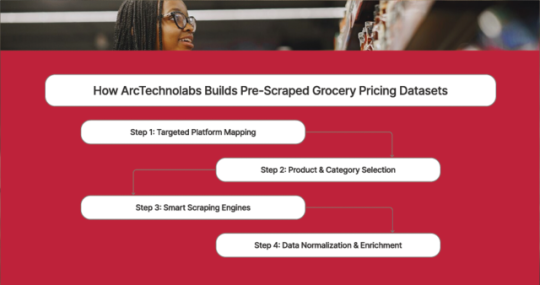
Step 1: Targeted Platform Mapping
UK: Tesco (Superstore), Ocado (Online-only)
AU: Coles (urban + suburban), Woolworths (nationwide chain)
Step 2: SKU Categorization
Dairy
Snacks & Beverages
Staples (Rice, Wheat, Flour)
Household & Personal Care
Fresh Produce (location-based)
Step 3: Smart Scraping Engines
Rotating proxies
Headless browsers
Captcha solvers
Throttling logic
Step 4: Data Normalization & Enrichment
Product names, pack sizes, units, currency
Price history, stock status, delivery time
Sample Dataset: UK Grocery (Tesco vs Sainsbury’s)
ProductTesco PriceSainsbury’s PriceDiscount TescoStock1L Semi-Skimmed Milk£1.15£1.10NoneIn StockHovis Wholemeal Bread£1.35£1.25£0.10In StockCoca-Cola 2L£2.00£1.857.5%In Stock
Sample Dataset: Australian Grocery (Coles vs Woolworths)
Product Comparison – Coles vs Woolworths
Vegemite 380g
--------------------
Coles: AUD 5.20 | Woolworths: AUD 4.99
Difference: AUD 0.21
Discount: No
Dairy Farmers Milk 2L
---------------------------------
Coles: AUD 4.50 | Woolworths: AUD 4.20
Difference: AUD 0.30
Discount: Yes
Uncle Tobys Oats
------------------------------
Coles: AUD 3.95 | Woolworths: AUD 4.10
Difference: -AUD 0.15 (cheaper at Coles)
Discount: No
What’s Included in ArcTechnolabs’ Datasets?
Attribute Overview for Grocery Product Data:
Product Name: Full title with brand and variant
Category/Subcategory: Structured food/non-food grouping
Retailer Name: Tesco, Sainsbury’s, etc.
Original Price: Base MRP
Offer Price: Discounted/sale price
Discount %: Auto-calculated
Stock Status: In stock, limited, etc.
Unit of Measure: kg, liter, etc.
Scrape Timestamp: Last updated time
Region/City: London, Sydney, etc.
Use Cases for FMCG Brands & Retailers
Competitor Price Monitoring – Compare real-time prices across platforms.
Retailer Negotiation – Use data insights in B2B talks.
Promotion Effectiveness – Check if discounts drive sales.
Price Comparison Apps – Build tools for end consumers.
Trend Forecasting – Analyze seasonal price patterns.
Delivery & Formats
Formats: CSV, Excel, API JSON
Frequencies: Real-time, Daily, Weekly
Custom Options: Region, brand, platform-specific, etc.
Book a discovery call today at ArcTechnolabs.com/contact
Conclusion
ArcTechnolabs delivers grocery pricing datasets with unmatched speed, scale, and geographic depth for brands operating in UK and Australia’s dynamic FMCG ecosystem.
Source >> https://www.arctechnolabs.com/arctechnolabs-grocery-pricing-datasets-uk-australia.php
#ReadyToUseGroceryPricingDatasets#AustraliaGroceryProductDataset#TimeSeriesUKSupermarketData#WebScrapingGroceryPricesDataset#GroceryPricingDatasetsUKAustralia#RetailPricingDataForQCommerce#ArcTechnolabs
0 notes
Text
COSMIC Jcink Skin
COSMIC is a $60 (CAD) fully responsive, mobile-friendly Jcink skin. I’ve made it as user-friendly as possible with easy-to-edit variables and cues within the HTML which are also in the installation guide. No templates are included currently but a set will be coming. "Template Set #1 - DAYLIGHT" set is fully functional with this skin. Preview and purchase at: https://ko-fi[dot]com/s/e83645a23b Please read my terms of service before purchasing: hexxincodes.tumblr.com/post/721896465243537408/terms-conditions DETAILS - All colours, fonts, and images set as variables for easy editing - Dark/light toggle - Full HTML templates - Isotope member list - Guidebook with 18 tabs set - Skin changes colors according to member group (10 set up) - Tabbed profile app - Half and full forums - Forums easy to switch between image + description and just description - Forums change accents w/ last poster - Full installation guide - Comes with post auto-saver UPON PURCHASE - Full xml file - HTML templates xml file - Profile fields json - Installation guide pdf - Guidebook txt file CREDITS Isotope memberlist script is by Essi, the dark/light toggle script was created by Yuno, #CODE script is by Nicole/Thunderstruck, icons are from Cappucicons, post autosaver by Black.


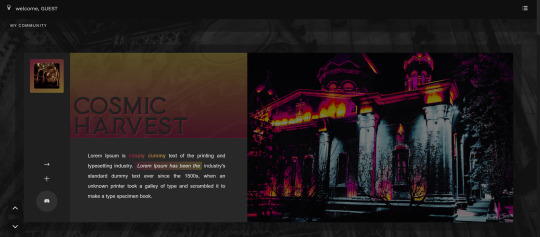


14 notes
·
View notes
Text
How to Integrate WooCommerce Scraper into Your Business Workflow
In today’s fast-paced eCommerce environment, staying ahead means automating repetitive tasks and making data-driven decisions. If you manage a WooCommerce store, you’ve likely spent hours handling product data, competitor pricing, and inventory updates. That’s where a WooCommerce Scraper becomes a game-changer. Integrated seamlessly into your workflow, it can help you collect, update, and analyze data more efficiently, freeing up your time and boosting operational productivity.

In this blog, we’ll break down what a WooCommerce scraper is, its benefits, and how to effectively integrate it into your business operations.
What is a WooCommerce Scraper?
A WooCommerce scraper is a tool designed to extract data from WooCommerce-powered websites. This data could include:
Product titles, images, descriptions
Prices and discounts
Reviews and ratings
Stock status and availability
Such a tool automates the collection of this information, which is useful for e-commerce entrepreneurs, data analysts, and digital marketers. Whether you're monitoring competitors or syncing product listings across multiple platforms, a WooCommerce scraper can save hours of manual work.
Why Businesses Use WooCommerce Scrapers
Before diving into the integration process, let’s look at the key reasons businesses rely on scraping tools:
Competitor Price Monitoring
Stay competitive by tracking pricing trends across similar WooCommerce stores. Automated scrapers can pull this data daily, helping you optimize your pricing strategy in real time.
Bulk Product Management
Import product data at scale from suppliers or marketplaces. Instead of manually updating hundreds of SKUs, use a scraper to auto-populate your database with relevant information.
Enhanced Market Research
Get a snapshot of what’s trending in your niche. Use scrapers to gather data about top-selling products, customer reviews, and seasonal demand.
Inventory Tracking
Avoid stockouts or overstocking by monitoring inventory availability from your suppliers or competitors.
How to Integrate a WooCommerce Scraper Into Your Workflow
Integrating a WooCommerce scraper into your business processes might sound technical, but with the right approach, it can be seamless and highly beneficial. Whether you're aiming to automate competitor tracking, streamline product imports, or maintain inventory accuracy, aligning your scraper with your existing workflow ensures efficiency and scalability. Below is a step-by-step guide to help you get started.
Step 1: Define Your Use Case
Start by identifying what you want to achieve. Is it competitive analysis? Supplier data syncing? Or updating internal catalogs? Clarifying this helps you choose the right scraping strategy.
Step 2: Choose the Right Scraper Tool
There are multiple tools available, ranging from browser-based scrapers to custom-built Python scripts. Some popular options include:
Octoparse
ParseHub
Python-based scrapers using BeautifulSoup or Scrapy
API integrations for WooCommerce
For enterprise-level needs, consider working with a provider like TagX, which offers custom scraping solutions with scalability and accuracy in mind.
Step 3: Automate with Cron Jobs or APIs
For recurring tasks, automation is key. Set up cron jobs or use APIs to run scrapers at scheduled intervals. This ensures that your database stays up-to-date without manual intervention.
Step 4: Parse and Clean Your Data
Raw scraped data often contains HTML tags, formatting issues, or duplicates. Use tools or scripts to clean and structure the data before importing it into your systems.
Step 5: Integrate with Your CMS or ERP
Once cleaned, import the data into your WooCommerce backend or link it with your ERP or PIM (Product Information Management) system. Many scraping tools offer CSV or JSON outputs that are easy to integrate.
Common Challenges in WooCommerce Scraping (And Solutions)
Changing Site Structures
WooCommerce themes can differ, and any update might break your script. Solution: Use dynamic selectors or AI-powered tools that adapt automatically.
Rate Limiting and Captchas
Some sites use rate limiting or CAPTCHAs to block bots. Solution: Use rotating proxies, headless browsers like Puppeteer, or work with scraping service providers.
Data Duplication or Inaccuracy
Messy data can lead to poor business decisions. Solution: Implement deduplication logic and validation rules before importing data.
Tips for Maintaining an Ethical Scraping Strategy
Respect Robots.txt Files: Always check the site’s scraping policy.
Avoid Overloading Servers: Schedule scrapers during low-traffic hours.
Use the Data Responsibly: Don’t scrape copyrighted or sensitive data.
Why Choose TagX for WooCommerce Scraping?
While it's possible to set up a basic WooCommerce scraper on your own, scaling it, maintaining data accuracy, and handling complex scraping tasks require deep technical expertise. TagX’s professionals offer end-to-end scraping solutions tailored specifically for e-commerce businesses. Whether you're looking to automate product data extraction, monitor competitor pricing, or implement web scraping using AI at scale. Key Reasons to Choose TagX:
AI-Powered Scraping: Go beyond basic extraction with intelligent scraping powered by machine learning and natural language processing.
Scalable Infrastructure: Whether you're scraping hundreds or millions of pages, TagX ensures high performance and minimal downtime.
Custom Integration: TagX enables seamless integration of scrapers directly into your CMS, ERP, or PIM systems, ensuring a streamlined workflow.
Ethical and Compliant Practices: All scraping is conducted responsibly, adhering to industry best practices and compliance standards.
With us, you’re not just adopting a tool—you’re gaining a strategic partner that understands the nuances of modern eCommerce data operations.
Final Thoughts
Integrating a WooCommerce scraper into your business workflow is no longer just a technical choice—it’s a strategic advantage. From automating tedious tasks to extracting market intelligence, scraping tools empower businesses to operate faster and smarter.
As your data requirements evolve, consider exploring web scraping using AI to future-proof your automation strategy. And for seamless implementation, TagX offers the technology and expertise to help you unlock the full value of your data.
0 notes